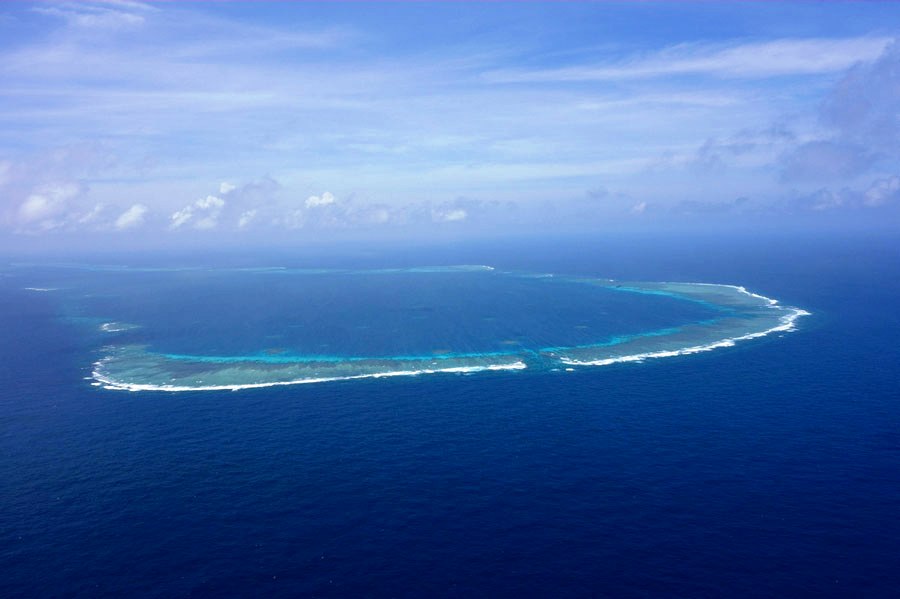Facts prove who is changing the status quo in South China Sea


For some time, "unilateral change of the status quo" has become a cliché of some Western countries when talking about the South China Sea disputes and other maritime and security issues in the Asia-Pacific, with implicit reference invariably pointed to China. It has become a customary practice for the Western countries to label other countries while "changing black into white". However, "black is black, white is white". No one can change the fact that "the US and some other Western countries want to deliberately change the status quo in the South China Sea".
The "status quo in the South China Sea" is based on facts rather than fabrication. The original state of the "status quo in the South China Sea" is China's sovereignty and sovereign rights and interests over the South China Sea islands and adjacent waters it has developed and established in the course of long history. Since the late Qing Dynasty at the second half of the 19th century, Japan, France and some other countries coveted the South China Sea. They illegally occupied the islands and reefs in the South China Sea and plundered resources there, in an attempt to change the "status quo in the South China Sea". In November 1943, the Cairo Declaration, signed by China, the US, and the UK, made clear that "It is their purpose…that all the territories Japan has stolen from the Chinese, such as Manchuria, Formosa, and The Pescadores, shall be restored to the Republic of China." The Potsdam Proclamation, jointly issued by China, the US, the UK, and the Soviet Union in July 1945, reiterated that "Japanese sovereignty shall be limited to the islands of Honshu, Hokkaido, Kyushu, Shikoku and such minor islands as we determine." In 1946, based on the above two international legal instruments, the Chinese government restored its sovereignty over the South China Sea Islands illegally occupied by Japan, and in 1948, published the South Sea Islands Location Map. This map delineated the scope of China's claim to maritime jurisdiction in the South China Sea with an 11-dash line and indicated the geographical positions of the Dongsha, Xisha, Zhongsha and Nansha Islands, which has become an important historical and legal basis for China's territorial sovereignty over the South China Sea Islands and its maritime jurisdiction claim. Therefore, maintaining the status quo in the South China Sea means safeguarding China's sovereignty and sovereign rights over the South China Sea Islands and their adjacent waters.
To maintain peace and stability in the South China Sea, the fundamental purpose of upholding the "status quo in the South China Sea" should be to manage differences and prevent further infringement against China's rights. In the late 1960s and early 1970s, the Philippines supported by the US and Vietnam backed by the Soviet Union began to put forward territorial claims to some islands and reefs in China's Nansha Islands, and took steps to occupy them illegally by means of force, the start of their infringement on China's rights and claims to the South China Sea.
As the US and the Soviet Union withdrew their forces from the South China Sea with the end of the Cold War in the 1990s, China and ASEAN countries started to build a mechanism for managing crises and enhancing mutual trust, and finally signed the Declaration on the Conduct of Parties in the South China Sea in 2002 (DOC). As the first political document to maintain peace and stability in the South China Sea and enhance mutual trust, the DOC reached a consensus on what the parties "should do" and "should not do". In 2013, in light of changing dynamics on the sea, China and ASEAN countries started consultations on the Code of Conduct in the South China Sea (COC), for enduring peace and stability as well as a new order that is "inclusive, fair and just" in the South China Sea.
The goal of maintaining the "status quo in the South China Sea" should be to promote the resolution of disputes in the South China Sea through friendly dialogue and consultations among the parties to the disputes. From the DOC, the bilateral consultation mechanisms China built with the Philippines, Vietnam and Malaysia, to the growing consensus on managing differences, China and other parties are always committed to peaceful settlement of disputes in the South China Sea through equal-footed and friendly consultations among the direct parties to the disputes. The dual-track approach advocated by China in 2014 was the best example of its efforts to safeguard the status quo in the South China Sea, which has been recognized by all neighboring countries in the South China Sea. Following this approach, China and ASEAN countries have made a series of visible early harvests, including the completion of the first and second reading of the COC draft text and the agreement on the guiding principles for early conclusion of the COC.
Who broke the status quo?
Looking back at Chinese history of the South China Sea, one will find it is the Western colonial powers—France, Japan, Britain, Germany and other imperialist powers in modern times and the US today—that broke the status quo in the South China Sea.
In particular, since its pivot to Asia in 2010, the US has made the South China Sea a "hunting ground" to contain China, a "target range" to show off its muscle, and a "training ground" to consolidate its alliance system. The US has become a destabilizing factor and troublemaker when China and ASEAN countries work hard to maintain peace and stability in the South China Sea.
The US-led militarization of the South China Sea followed by its allies and with China as the imaginary enemy is the accelerator in the shift of the status quo in the South China Sea. The US has geared up its forward military deployment in Southeast Asia from the Obama administration to the Biden administration and from its Pivot to Asia to the "Indo-Pacific" strategy. Based on its Enhanced Defense Cooperation Agreement, the US is building a group of military bases facing the South China Sea in the Philippines, with China as its target. Since 2015, the US has significantly and substantially upgraded its military operations in the South China Sea, with much greater frequency of bilateral and multilateral joint military exercises, "freedom of navigation operations" (FONOPs), and air and sea close-in reconnaissance. In 2022 alone, the US large military reconnaissance aircraft conducted more than 1,000 sorties of close-in reconnaissance missions in the South China Sea. At the same time, guided by its Cold War mentality, the US aims to strengthen its military hegemony and contain China as well as to build and lead a regional security architecture centered on the South China Sea. Small groups established in recent years, such as the quadrilateral security dialogue among the US, Japan, India and Australia (the Quad) as well as US-Philippines-Japan alliance and US-Philippines-Australia alliance are cases in point of the changing status quo in the South China Sea.
The US defines the maritime order dominated by itself with the pseudo-proposition of the rule-based international order and, on this basis, identifies whoever tries to challenge this order as changing the status quo in the South China Sea. The "rule-based international order" concocted by the US is essentially a cover for its hegemony. It is deliberately ambiguous about such fundamental issues as "what is a rule-based international order", "who defines these rules", and "the relationship between these rules and the recognized international order". In fact, these rules only serve the US hegemony and interests, and the US has the sole right to define and interpret this narrative system, a system which is a far cry from the international rules composed of modern international law and international practices based on fairness and justice. For example, the US military actions in the South China Sea to "challenge excessive maritime claims" is essentially nothing more than provocative military operations in the name of "freedom of navigation" and "rule-based order", maneuvers aimed at maintaining maritime hegemony and weakening China's ability to uphold the existing order in the South China Sea. Another example is the US behind-the-scenes manipulation of the South China Sea arbitration case initiated by the Philippines, a typical case of abusing the rules of modern international law and undermining the status quo in the South China Sea through legal means.
While completing the circle on their containment of the rise of China's maritime power, the US and its allies are pursuing a "grey zone strategy" and disrupted maritime cooperation and ocean governance of the South China Sea. The US is skillfully using a "gray zone strategy" to seek to change the status quo in the South China Sea, while making the false claim that China is doing the same thing. In May 2022, the Quad Leaders' Summit announced the establishment of a new Indo-Pacific Partnership for Maritime Domain Awareness (IPMDA), seeking to connect existing monitoring centers in Singapore, India and the South Pacific region with satellite technology and build a maritime sensing information network covering the Indian Ocean, Southeast Asia to the South Pacific to watch and curb "illegal" fishing activities of China and some other countries. Under this mechanism, the US signed bilateral shiprider agreements with some Southeast Asian countries and introduced maritime law enforcement capability enhancement programs for them. In the name of combating IUU fishing and protecting marine environment, the US makes regular deployment of coast guard vessels in the South China Sea, leveraging its military facilities in Japan, Singapore, the Philippines and other countries, to assist its navy in conducting FONOPs against China, which has seriously interfered with China's efforts to maintain the status quo of peace and stability in the South China Sea.
In combating IUU fishing and promoting IPMDA in the non-military sectors, the US is seeking to leverage the strengths of its allies and partners, integrate commercial resources, and set up a maritime information and intelligence network in the "Indo-Pacific" region to satisfy its hegemonic needs. This has cast a shadow of geopolitical competition on existing cooperation on fishing, environmental protection and navigation safety in the South China Sea.
By adjusting its South China Sea policy, the US has condoned or acquiesced in the unilateral infringement actions of claimant countries, subverting the status quo of bi-lateral and multilateral cooperation between China and ASEAN countries based on the DOC. With the change of its South China Sea policy, the US has sent a signal to some claimant countries and instigated them to take unilateral infringement actions, including control and expansion of islands and reefs, oil and gas development in disputed areas, and strengthened de facto control of maritime areas in order to expand and firm up their claims. The narrowing window for the COC consultations, underestimate or misjudgment on China's firm resolve in taking countermeasures, and the South China Sea arbitration have made some claimant countries to intensify their infringement activities. Since 2017, one claimant country after another has carried out unilateral oil and gas activities in the contested waters. Vietnam conducted landfill work and deployed facilities on the islands and reefs it illegally occupied in the South China Sea at an alarming pace. Since 2021, it reclaimed more than 3 square kilometers of land and built a number of facilities, including several harbor piers for warships of more than 1,000 tons. It also plans to build military airport runways on some of the islands and reefs. Since 2023, the Philippines has wantonly sabotaged "temporary special arrangement" with China on Ren'ai Reef in the Nansha Islands and Huangyan Island in the Zhongsha Islands, unilaterally cut off the prior communication mechanism between the two countries on the humanitarian resupply for Ren'ai Reef, and repeatedly violated the "gentleman's agreement" by carrying materials that go far beyond the scope of humanitarianism and that are used for the construction of fixed facilities for permanent possession of Ren'ai Reef. The Marcos government in the Philippines has taken provocative actions to change the status quo in the South China Sea, and one could not ignore the US factor behind it.
False claims against China
By fabricating the narrative that China is posing a threat to the South China Sea, the US is attempting to dress up as a defender of fairness and justice as well as a guardian against "the big bullying the small" in the South China Sea, in order to induce China's neighboring countries to take sides with the US. The US is well aware that the logic of hegemony is unpopular, and it is even more difficult to enlist Southeast Asian countries that follow the strategy of balance of powers. Therefore, the US make up the fiction that China is a common challenge, a threat to the South China Sea, and a "sabotager" of the status quo of the South China Sea, putting on the labels of "coercion", "intimidation" and "bullying" on China. It attempts to shift the blame for growing tensions in the South China Sea to China, in order to escalate the disputes between China and ASEAN countries and bring some of them to its fold.
The US is making an excuse for its military deployments and actions in the South China Sea out of its geopolitical interests. The US is neither a littoral state to the South China Sea nor a party to the dispute. For its special geographic location connecting major economies of the world and the Indian and Pacific Oceans, the South China Sea must be under the US control if it is to maintain its military and maritime hegemony. To cover up its sheer hegemony in the South China Sea and gain some degree of legitimacy, the US has to develop a tailor-made set of rhetorics. It is a customary practice for the US to preset targets and create hypothetical enemies before carrying out its intervention strategy globally. When arguing the status quo in the South China Sea is being changed, the US has the underlying message that China is seeking hegemony by means of force in the South China Sea through militarization of the Sea, which seems to provide justification for the US to build military bases, make forward deployment and push for confrontation between blocks in the South China Sea.
The US is hyping up tensions caused by changing status quo in the South China Sea, to drive a wedge in China's relations with ASEAN countries, especially the claimant countries. Proxy war is an indispensable tool in recent years for the US to weaken and restrain its opponents. The US has revived its proxy strategy and applied it to the South China Sea time and again. In the final analysis, the US aims to demonize China's legitimate actions to defend its rights to the South China Sea, to create fear among the neighboring countries and the international community of China's development of maritime power, and to shape the recognition of the US strategy and deployment in the South China Sea.
Forming alliances to hurt China
The US is seeking legitimacy for its new alliance and partnership system to contain China's rising power on the sea. In its National Security Strategy Report 2022, the Biden administration defined China as a power with both the intention and the capacity to reshape the international order and argued that the next 10 years would be key to win the competition against China. In the South China Sea, the US has picked up the Cold War mentality to maintain its hegemony. Claiming that China is posing a threat and changing the status quo of the South China Sea, the US has joined hands with countries inside and outside the region, including Japan, Australia, the Philippines and Vietnam, to build mini-lateral security mechanisms tailor-made against China. They are deepening security cooperation, holding joint military exercises and strengthening the "island chain" strategy, to stop and prevent China from challenging the US maritime supremacy.
The author is chairman of Huayang Center for Maritime Cooperation and Ocean Governance, chairman of the Academic Committee of China's National Institute for South China Sea Studies, and chair professor at Xiamen University.
The views don't necessarily reflect those of China Daily.


































